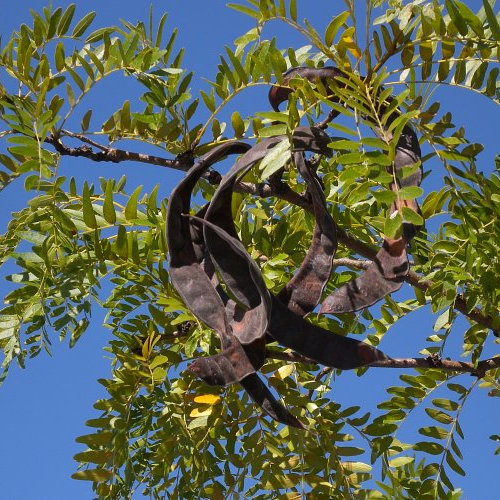The honey locust tree (Gleditsia triacanthos) is a deciduous tree native to North America and is known for its numerous benefits and various uses:
- Ornamental Landscaping: Honey locust trees are commonly used in landscaping due to their attractive appearance. They have delicate, fern-like leaves that create a light, dappled shade, making them an excellent choice for parks, gardens, and streetscapes.
- Wildlife Habitat: The honey locust tree provides habitat and food for various wildlife species. Birds, squirrels, deer, and other animals feed on its seeds and foliage, contributing to local biodiversity.
- Nitrogen Fixation: Honey locust trees are nitrogen-fixing plants. They have specialized root nodules that host nitrogen-fixing bacteria. This process converts atmospheric nitrogen into a form usable by plants, enriching the soil and benefiting surrounding vegetation.
- Edible Seed Pods: The tree produces seed pods that contain sweet, edible pulp. These pods are not only enjoyed by wildlife but can also be consumed by humans. They can be eaten raw or processed into various culinary creations, such as sweeteners, jams, and syrups.
- Medicinal Uses: Some traditional medicinal systems use different parts of the honey locust tree for therapeutic purposes. For instance, the bark, leaves, and seed pods have been used in herbal medicine to treat various ailments.
- Timber and Woodworking: The dense, hard, and durable wood of the honey locust tree makes it suitable for a range of woodworking applications. It is used to make furniture, flooring, fence posts, and other items.
- Erosion Control: The honey locust's deep root system helps stabilize soil and prevents erosion, making it valuable for land restoration and reforestation projects.
- Shade and Windbreaks: The tree's spreading canopy offers ample shade during hot summer months, making it a pleasant spot to rest outdoors. Additionally, honey locust trees are sometimes planted as windbreaks to protect fields and homes from strong winds.
- Honey Production: As the name suggests, honey locust trees are a source of nectar for bees. Beekeepers may place hives near honey locust groves to produce a distinct variety of honey.
- Firewood and Fuel: The wood of the honey locust tree, when properly dried, burns well and produces significant heat, making it a viable option for firewood and fuel.
It's important to note that while honey locust trees offer numerous benefits, they also have some drawbacks. They can be thorny, making maintenance and harvesting seed pods challenging. Additionally, their seed pods can create a mess when they fall, which may not be ideal for high-traffic areas or where lawn maintenance is crucial. Nevertheless, when appropriately managed, honey locust trees can be valuable assets to both the environment and human society.
Growing from seed
Growing a honey locust tree from seed can be a rewarding and straightforward process. Here's a step-by-step guide to help you get started:
- Seed Scarification: Honey locust seeds have a hard seed coat that may prevent water absorption and hinder germination. To improve germination rates, scarify the seeds by either nicking the seed coat with a knife or gently sanding it with sandpaper. This will create small openings for water to enter and initiate germination.
- Cold Stratification: Honey locust seeds benefit from cold stratification to break their dormancy. Place the scarified seeds in a container with damp sand or peat moss. Seal the container and store it in a refrigerator at around 1 to 5°C for about 60 to 90 days. This mimics the natural winter conditions that the seeds would experience before germinating in spring.
- Potting Soil and Containers: While the seeds are undergoing cold stratification, prepare the planting containers. Use pots or trays with good drainage holes and fill them with a well-draining potting mix. You can create a mix by combining equal parts of potting soil, sand, and perlite.
- Planting the Seeds: After the cold stratification period is complete, take the seeds out of the refrigerator and sow them in the prepared containers. Plant the seeds about 1 to 2 inches deep in the soil. Water the soil gently to ensure it's moist but not waterlogged.
- Location and Light: Place the containers in a sunny location that receives partial to full sunlight. A sunny windowsill or a greenhouse with adequate light will work well.
- Watering and Care: Keep the soil consistently moist but avoid overwatering, as this can lead to rot. As the seedlings grow, make sure to provide adequate water and protection from extreme weather conditions.
- Transplanting: When the seedlings have grown to a suitable size and have developed a strong root system (usually after a year or two), you can transplant them outdoors in the desired location. Choose a spot with full sun to partial shade and enough space for the tree to grow to its mature size.
- Maintenance: Young honey locust trees may benefit from some light pruning to encourage a healthy shape and growth. As they mature, they generally require minimal maintenance.
Remember that growing trees from seeds can be a time-consuming process, but it can be incredibly rewarding to see your honey locust tree grow and thrive over the years.

